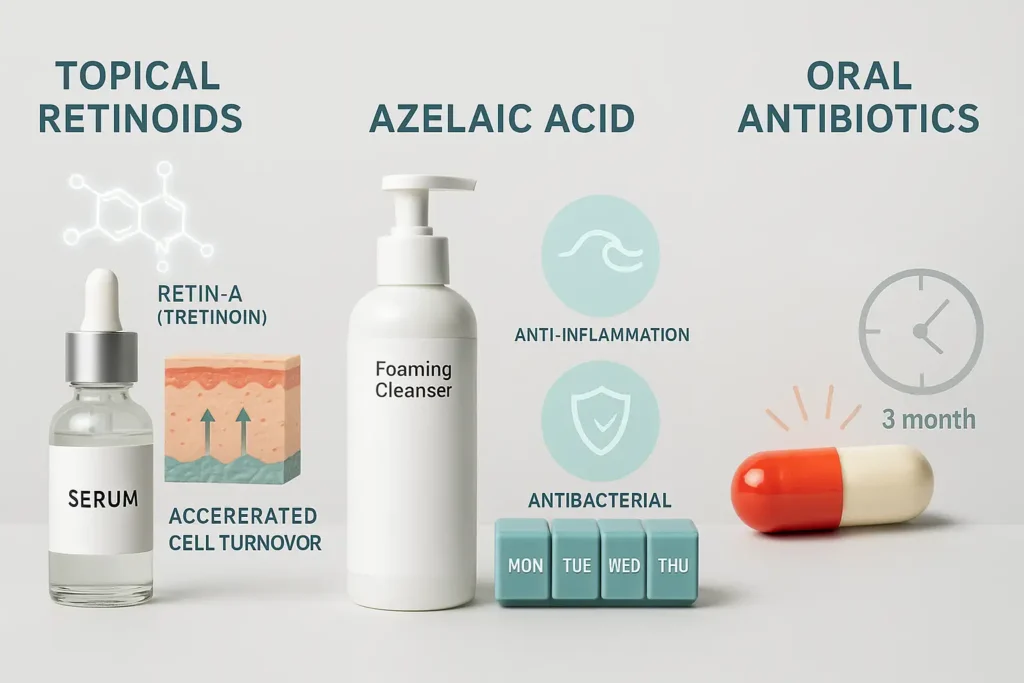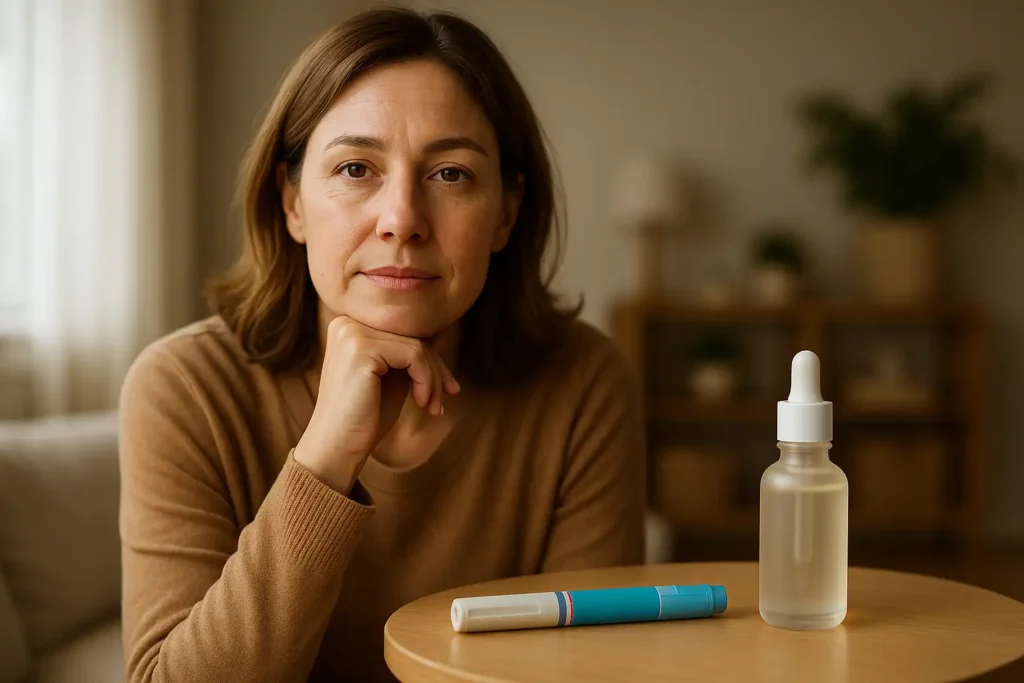The connection between Acne and GLP-1 Agonists is emerging as a surprising focus of new research. While medications like Ozempic® and Mounjaro® are celebrated for their effectiveness in managing diabetes and weight, a growing number of users and dermatologists are reporting an unexpected side effect: new or worsening acne breakouts. This isn’t just a coincidence; early clinical observations are now investigating this very link.
If you’ve started a GLP-1 agonist and noticed a change in your skin, you’re not alone. This post breaks down the latest findings on Acne and GLP-1 Agonists, explaining the potential causes and providing a clear action plan for those affected.
A Quick Refresher: What Are GLP-1 Agonists?
Before we get to the breakouts, let’s quickly review what GLP-1 receptor agonists are. These drugs mimic a natural hormone in your body called Glucagon-Like Peptide-1 (GLP-1). They work by:
- Stimulating insulin release when blood sugar is high.
- Slowing down digestion by keeping food in your stomach longer.
- Sending signals to your brain that you’re full.
The result is better blood sugar control for people with type 2 diabetes and significant, sustained weight loss for many individuals. The most well-known include semaglutide (Ozempic, Wegovy) and tirzepatide (Mounjaro, Zepbound).
The Headline Study: Early Reports of “Ozempic Face” and Acne
The conversation around GLP-1 agonists and skin health entered the mainstream medical dialogue largely thanks to a specific research letter published in the prestigious Journal of the American Medical Association (JAMA) Dermatology in May 2024. This letter, titled “Semaglutide-Associated Adverse Skin Reactions” served as a crucial early-warning system from clinicians in the field.
The researchers reported a striking clinical observation: at their institution, a significant number of patients—particularly middle-aged women—being treated with semaglutide (the active ingredient in Ozempic and Wegovy) were presenting with new-onset or significantly worsened acne. It’s important to distinguish the type of acne described. This wasn’t the occasional pimple; the reports detailed cases of “inflammatory pustules and nodules,” which often manifest as deep, sometimes painful bumps under the skin, primarily concentrated on the face and, in some cases, even extending to the chest and back.
Understanding the “Why” Behind the Study’s Design
It is crucial to contextualize what this study is and is not. This was not a large-scale, randomized controlled trial (RCT) designed to prove causation. Instead, it was a “correspondence” or “research letter”—a format used by physicians to report interesting clinical observations and potential patterns that warrant further investigation.
Think of it as a doctor raising their hand in a scientific meeting and saying, “Hey, I’m seeing this specific thing in my patients quite frequently, and we should look into it.” This is how many side effects are first identified—through astute clinical observation before they are confirmed by massive, expensive trials.
The Critical Limitation: Correlation vs. Causation
This distinction is vital. The researchers identified a strong correlation—a pattern where two things (using semaglutide and developing acne) are happening together. However, they have not yet proven a direct cause-and-effect relationship in a broad population.
This early signal is compelling enough to demand attention and further research, but it means that while the link is highly plausible, it is not yet considered a definitive, proven side effect on the official drug label. This also explains why the exact incidence—what percentage of users experience this—remains unknown.
Connecting to “Ozempic Face”
This research also connects to the broader, popular term “Ozempic Face.” While this term was initially coined to describe the facial aging and volume loss that can occur from rapid weight loss, the JAMA Dermatology letter expanded the conversation. It suggested that the skin-related side effects of GLP-1 agonists aren’t just about fat loss, but may also include specific inflammatory conditions within the skin itself, like the acne outbreaks they observed. This places acne as a distinct, though potentially related, component of the complex changes these drugs can trigger in the body.
The “Why” Behind the Breakouts: Potential Mechanisms
So, how could a drug that manages blood sugar and weight lead to skin issues? Researchers and dermatologists have proposed several compelling theories.
1. Rapid Weight Loss and Hormone Fluctuations
This is the leading theory. Fat cells (adipose tissue) don’t just store energy; they also produce and store hormones, particularly estrogen. When you lose weight rapidly, these stored hormones are released into your bloodstream. This sudden flood can disrupt your delicate hormonal balance, potentially triggering hormonal acne—the kind that typically appears around the jawline, chin, and mouth.
2. The Gut-Skin Axis
The gut-skin axis is the complex communication network between your digestive system and your skin. Since GLP-1 agonists profoundly slow gut motility, they may alter the composition of your gut microbiome. An imbalance in gut bacteria can lead to systemic inflammation, which is a known trigger for inflammatory skin conditions like acne.
3. Direct Effects on Sebaceous Glands and Other Hormones
While more research is needed, there is speculation that GLP-1 receptors might be present in the skin or that the drug’s effect on other gut hormones (like GIP) could indirectly influence the oil-producing sebaceous glands. More oil production can mean more clogged pores and a better environment for acne-causing bacteria to thrive.

What Does This GLP-1-Related Acne Look Like?
If you’re developing acne after starting a GLP-1 agonist, it likely isn’t the occasional random pimple. Based on emerging patient reports and clinical observations, the acne linked to these medications often presents in a distinct pattern that closely mirrors adult hormonal acne. Understanding its characteristics is the first step toward managing it effectively.
Here’s a more detailed breakdown of what you might see:
- Inflammatory Papules and Pustules: This is often the most visible sign. Papules are small, red, raised, and tender bumps caused by inflammation and infection in the clogged pores. Pustules are what we commonly call “whiteheads” – they are papules with a visible center of white or yellow pus. Unlike the small blackheads or whiteheads of comedonal acne, these are inflamed and can be painful to the touch.
- Cystic Nodules (Often called Cystic Acne): This is the more severe and distressing form. These are not superficial blemishes. Nodules are large, hard, painful lumps that develop deep beneath the skin’s surface. Cysts are similar but are deep, soft, and pus-filled. Because of their depth, they are often the most painful type of acne and carry a higher risk of leading to post-inflammatory hyperpigmentation (dark spots) or scarring after they heal.
- The “Hormonal” Pattern: Concentrated on the Lower Face: Location is a major clue. While traditional teenage acne often appears on the forehead, nose, and cheeks (the “T-zone”), GLP-1-related breakouts overwhelmingly favor the “beard distribution” or “U-zone” in adults. You will typically find a concentration of lesions along the jawline, chin, and the lower part of the cheeks. Some individuals may also experience breakouts on the neck, chest, and upper back.
Key Characteristics at a Glance:
| Feature | Typical GLP-1 Related Acne | Common Teenage Acne |
|---|---|---|
| Type | Inflammatory papules, pustules, and deep cysts | A mix of blackheads, whiteheads, and inflammatory pimples |
| Location | Jawline, chin, lower cheeks (the “U-zone”) | Forehead, nose, and cheeks (the “T-zone”) |
| Sensation | Often tender, painful, or deep-seated | Can be inflamed, but not always deeply painful |
| Texture | Can feel like deep, hard lumps under the skin | More often surface-level or slightly raised bumps |
Recognizing this specific pattern—deep, inflammatory, and centered on the lower face—can help you and your dermatologist determine if your breakouts are likely a side effect of your medication, allowing for a more targeted and effective treatment approach.
What to Do If You’re on a GLP-1 and Breaking Out
If you’re experiencing this frustrating side effect, don’t panic. Here are the steps you should take.
Step 1: Do NOT Stop Your Medication
This is the most important rule. Never discontinue a prescribed medication without first consulting your doctor. The benefits for your metabolic health or weight management may far outweigh the temporary challenge of acne.
Step 2: Consult Your Prescribing Doctor and a Dermatologist
Talk to the healthcare provider who prescribed your GLP-1 agonist. They can assess your overall situation. Then, schedule an appointment with a board-certified dermatologist. They are the experts in diagnosing and treating skin conditions and can create a tailored plan for you.

Step 3: Adopt a Gentle, Consistent Skincare Routine
While you seek professional advice, avoid the temptation to scrub your skin raw or use harsh, drying products. This can damage your skin barrier and make inflammation worse. Instead, focus on:
- A Gentle Cleanser: Use a non-stripping, fragrance-free cleanser twice daily.
- A Non-Comedogenic Moisturizer: Hydrated skin is healthy skin. Look for products labeled “oil-free” and “non-comedogenic” (won’t clog pores).
- Sunscreen Daily: Sun exposure can worsen acne inflammation and lead to post-inflammatory hyperpigmentation (dark spots).
Professional Treatment Options Your Dermatologist Might Suggest
Navigating acne that emerges during GLP-1 therapy can be frustrating, but you don’t have to face it alone. A board-certified dermatologist has a powerful and targeted arsenal to combat this specific type of inflammatory, hormonally-influenced acne. The goal of treatment is to control the breakouts, minimize pain and inflammation, and prevent lasting scarring or dark spots.
After an evaluation, your dermatologist may recommend one or a combination of the following approaches:
1. Topical Retinoids (e.g., Tretinoin, Adapalene, Tazarotene)
- How They Work: These are vitamin A derivatives and are the cornerstone of treating inflammatory and comedonal acne. They work by accelerating skin cell turnover, which helps to unclog pores, prevent new micro-comedones (the precursor to all pimples), and reduce inflammation.
- What to Expect: Your dermatologist will likely start you on a low strength and provide specific instructions for use, as retinoids can cause dryness, peeling, and irritation initially (a period often called “retinization”). They are a long-term solution and must be used consistently for best results.
2. Azelaic Acid (15%-20% Gel or Foam)
- How They Work: This is a versatile and well-tolerated agent that works on multiple fronts. It has potent anti-inflammatory properties to calm redness and swelling, it kills acne-causing bacteria (C. acnes), and it helps to normalize the shedding of skin cells within the follicle. A key benefit is that it also helps to fade post-inflammatory hyperpigmentation (the dark marks left after a pimple heals), which is common in skin of color.
- What to Expect: It is often used twice daily and can be an excellent option for those who find retinoids too irritating or for use in a morning routine.
3. Oral Spironolactone (Primarily for Women)
- How They Work: This is often the most effective oral medication for women with hormonally-driven acne, making it particularly relevant for GLP-1-related breakouts. Spironolactone is an anti-androgen; it blocks the effects of male hormones (like testosterone) on the oil glands in the skin. By reducing sebum (oil) production, it addresses one of the root causes of hormonal acne.
- What to Expect: It is not an antibiotic and is typically used as a long-term maintenance therapy. It can take 2-3 months to see full results. Your doctor will monitor your potassium levels and may caution about its potential diuretic effect. It is generally not prescribed for men due to the risk of feminizing side effects like breast tenderness.
4. Oral Antibiotics (e.g., Doxycycline, Minocycline)
- How They Work: These drugs, from the tetracycline class, are used for their potent anti-inflammatory effects at lower, sub-antimicrobial doses. They quickly reduce the population of acne-causing bacteria and calm the severe redness and swelling associated with deep papules and cysts.
- What to Expect: This is considered a short-term “bridge” therapy (typically 3-4 months) to gain rapid control of a severe flare-up while waiting for slower-acting treatments like spironolactone or topical retinoids to become fully effective. Long-term use is avoided to prevent antibiotic resistance and disruptions to the gut microbiome.
A Collaborative Approach is Key
It is crucial to maintain open communication with both your dermatologist and the provider who prescribed your GLP-1 medication. They can work together to ensure your acne management plan is effective without interfering with your primary health goals. With the right professional guidance, the acne associated with GLP-1 agonists is a manageable condition.
The Bottom Line: Weighing Benefits and Side Effects
The emergence of acne as a potential side effect is an important reminder that all powerful medications come with a complex profile of effects. It’s crucial to view this development through a lens of balance. For the vast majority of users, the profound benefits of GLP-1 agonist therapy—such as significantly improved blood sugar levels for diabetics, reduced risk of heart attack and stroke, and substantial weight loss that can alleviate conditions like sleep apnea and joint pain—will fundamentally outweigh the challenge of a manageable, and often treatable, skin condition.
This isn’t to dismiss the very real psychological and emotional impact of acne, which can be significant. Rather, it’s about placing it in the correct context of your overall health picture. The key is to avoid letting a treatable side effect derail a therapy that is addressing potentially life-altering chronic diseases.

The path forward is not a solitary choice between clear skin and good health, but a proactive strategy to achieve both. This requires an open, collaborative conversation with your entire healthcare team. Inform your prescribing physician about the skin changes you’re experiencing. Then, partner with a dermatologist who can provide targeted solutions. By addressing the acne head-on with a specialist, you can work effectively toward clear skin without having to compromise the primary and potentially life-saving health goals of your GLP-1 agonist therapy. Think of it as optimizing your treatment plan, not abandoning it.
Conclusion: Key Takeaways and the Need for Future Research
The emerging link between GLP-1 agonists and acne is a fascinating development that sits at the intersection of dermatology and endocrinology. It underscores a fundamental truth in medicine: as we powerfully intervene in one biological system, we must be vigilant in observing its effects on others. The current evidence, while preliminary, points to a real and plausible connection, most likely driven by the profound hormonal shifts and gut-skin interactions triggered by rapid metabolic change.
To recap the essential points:
- The Link is Plausible, Not Panic-Worthy: Early clinical observations have identified a pattern where patients on GLP-1 drugs report new or worsening acne, primarily of the inflammatory, hormonal type.
- You Have Agency and Options: If you are experiencing this side effect, it is not a hopeless situation. This is a manageable condition. A proactive partnership with your healthcare team—including your prescribing doctor and a dermatologist—is your most powerful tool.
- Treatment is Effective: From topical retinoids and azelaic acid to oral medications like spironolactone, there is a well-established arsenal to combat this specific type of acne, allowing you to pursue your primary health goals without sacrificing your skin health.
- Benefits Often Outweigh Side Effects: It’s crucial to contextualize this skin issue against the significant benefits of GLP-1 therapy, which for many include transformative improvements in metabolic health and reduced risk of serious chronic diseases.
Looking ahead, the critical need is for robust, future research. Large-scale, controlled studies are essential to definitively establish causation, determine the exact incidence rate across different populations, and unravel the precise biological mechanisms at play. This future knowledge will not only validate patient experiences but also lead to more predictive and personalized care, potentially helping to prevent this side effect altogether.
For now, if you find yourself navigating this unexpected side effect, remember: your journey is not just about managing a medication, but about optimizing your overall well-being. By staying informed, seeking the right professional support, and practicing patience, you can confidently manage your skin health while continuing on your path to better metabolic wellness.
Ressources
- Primary Research Letter:
- Link: JAMA Dermatology: “Semaglutide-Associated Adverse Skin Reactions”
- Description: The initial correspondence that sparked the discussion, detailing clinical observations of acne and other skin reactions in patients using semaglutide.
- Understanding GLP-1 Agonists:
- Link: Cleveland Clinic: “GLP-1 Agonists”
- Description: A reliable, patient-friendly overview of what GLP-1 receptor agonists are, how they work, and their primary uses for diabetes and weight management.
- American Academy of Dermatology (AAD) on Adult Acne:
- Link: AAD: “Adult Acne”
- Description: An essential resource from the leading dermatological association, offering general information on causes and treatment options for adult acne.
- In-Depth Look at Hormonal Acne:
- Link: Healthline: “Hormonal Acne”
- Description: A detailed article explaining the characteristics, causes, and treatments specific to hormonally-driven acne.
- The Gut-Skin Axis Explained:
- Link: National Library of Medicine: “The Gut-Skin Axis”
- Description: A scientific review article exploring the complex relationship between gut health and skin homeostasis, providing background on one of the potential mechanisms behind GLP-1-related acne.

